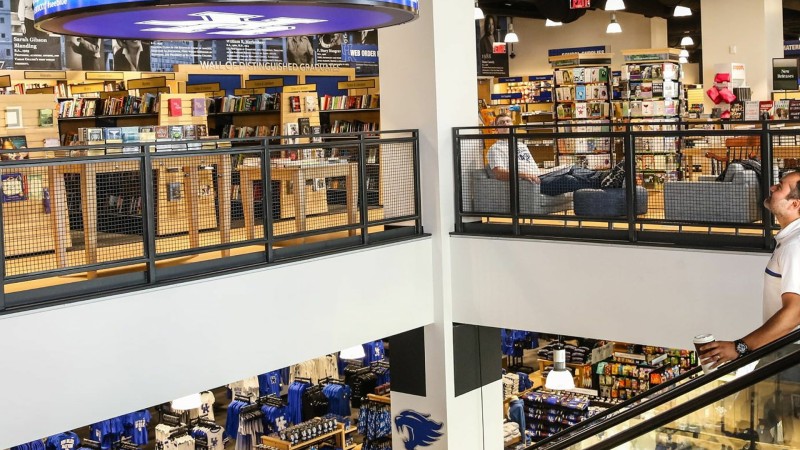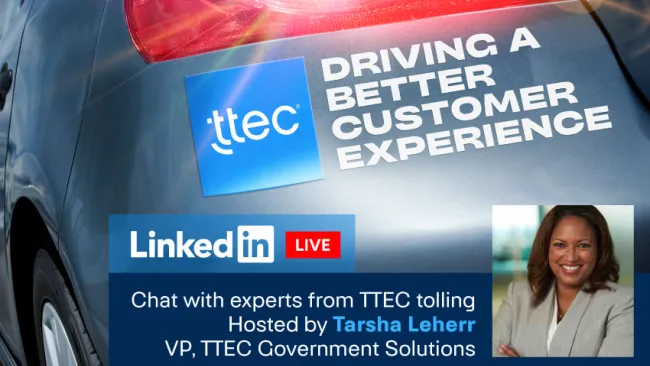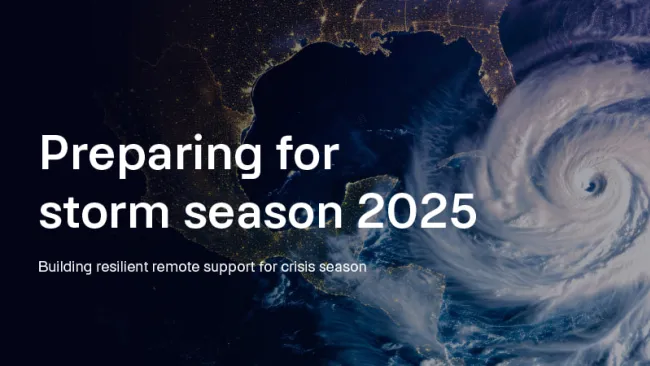As Generation Z heads off to college, Lisa Malet, COO of Barnes & Noble College, shares lessons and insights on what works—and doesn’t work—when to comes to staying top-of-mind with today’s students. Lesson one: If you’re chasing purely digital interactions, you’re already behind the curve.
Read more about Barnes & Noble College’s approach to Gen Z in the Fall 2019 issue of the Customer Strategist Journal.
Transcript: You're listening to see CX Pod by TTEC and the Customer Strategist journal.
Judith Aquino: Welcome to the CX Pod. I'm Judith Aquino and today we'll be talking about college textbooks. And more specifically, what does it take to get a student to purchase a textbook these days when they have multiple options? And what can other businesses learn about engaging these young consumers?
Joining me today to help me explore these questions is Lisa Malat, COO of Barnes & Noble College. Welcome to the show Lisa.
Lisa Malat: Great to be here. Thanks for having us.
JA: So as a campus bookseller, Barnes and noble college has a direct line to Gen Z, which is roughly, from what I understand between the ages of 4 and 24 right now. So can you tell me what's different about the Gen Z college student versus the previous generation?
LM: Yeah, it's very interesting because we've been studying the college consumer for many years now and you know, just as, as ourselves and retailers in general got used to and was figuring out the Millennials, Gen z hit our campuses.
And in fact, I think it's this year that we're really going to have our first graduating class of Gen Z. But what makes Gen Z uniquely different at, you know, what we're seeing is really about how they see themselves as individuals. You know, really how do they look at their value system, their, you know, aspirations and the importance of how that aligns with how they view themselves in the world. And what retailers and what brands they choose to associate with, right?
So, for example, they have a really strong sense of who they are as individuals and as a generation and they really identify them themselves as being incredibly kind and empathetic, you know, and really supporting individualism and they have a really strong belief in themselves and their potential to do anything right.
As part of that, they feel a really strong sense of responsibility to change the world and to correct things they see that they don't think are right. And to really be a voice and they believe they have the power to effect that change, which is really an incredible thing to witness you know, as you speak to these students in terms of their outlook on the future.
JA: So how do you take that kind of I guess intel about the customer that they have a strong sense of responsibility and individualism to convince them that they should buy from one of your bookstores?
LM: Right. So, you know, I think that just to step back on a little bit more on who we are as a brand. You know, we operate as really the official campus retailer on over 700 schools across the country. And our business and our spaces really represent all things college to students, right? So whether they need their, you know, their course materials to be ready on the first day of class, right. Or they need the latest school branded sweatshirts to go to the homecoming game where the latest technology to be prepared to learn. We provide all of that, our students.
So to answer your question, when you think about how has the student changed or how has retail change, you know, over the last 10 years or even five years, I think just technology has fueled such a democratization of information of choices, right?
So, you know, consumers today have an enormous amount of options and do an enormous amount of research before they make their purchases. So really the opportunity for retailers and the opportunity we saw for Barnes & Noble is how do we differentiate in the space? How do we optimize it? Take advantage of the incredible, you know, on campus presence we have in the front row seat that we have to the college experience and really go beyond the commoditization right, of product or the commoditization of textbooks or even school branded apparel and really move towards curation.
JA: Right. So I know there's a lot of advice out there on how to keep customers engaged and drive loyalty, doing things like personalizing the experience, surprise, delight your customer. And so I'm curious, do any of those tactics work, for Barnes & Noble college or do you find that something else resonates?
LM: You know, I do think that those things work. And I think though the most important thing though is relevancy as you go about those strategies. So I think that what we do very successfully and the advice I would really give to any retailer or any brand is just constantly being on the pulse and in the heads of your consumer. So we have a really large research and insights platform where we reach thousands of students on a daily basis serving them and getting into their minds on a variety of topics, including what their expectations are from a retail experience, what their expectations are from the campus store. And how do we meet and exceed them. Through all of that research students, we learned that brick and mortar matters. The physical space matters to Gen Z. You know they are digital natives, they live online, they live in social media. But the social connection and the experience of going into a store and being able to immerse themselves and engage with a brand or a retailer in their own personal way is critically important.
So as we do this research and we create these experiential moments in our stores as we build out these concept shops, like for example Judith graduation, right? So you've always had graduation product in our stores, but we never, you know, took the opportunity to really curate it together with things like, you know, books that speak to the journey post college or career success or even, you know, mental health and wellness or to create these spaces where parents and grandparents and family members and students can congregate and be able to imagine themselves as graduates to be able to create these Instagram-able moments in our stores. You know, where students are trying on their cap and gown and holding a diploma frame and say, "Hey mom, look at me. This is four years from now."
So to be able to create those moments at the right time in their journey has proven to be, you know, very impactful for us and our consumer.
JA: Great. And how do you analyze the research that you're gathering? Are you using like text analytics or some AI tools?
LM: Yeah, so we do have a software platform that we're using today. We are moving to a new platform in the next few weeks which we're super excited about, but you know, through that, through that software platform and our in house research department and experts we're able to really call out the insights and what's amazing about this generation that is so inspiring is the way they open up and share their, their voices, their concerns in these very extensive comments that they give us beyond just checking the boxes. So the kind of, the, you know, more of the qualitative piece of the research and really allowing us to understand at a deeper level what they're asking and what their needs is very effective.
JA: Great. What do you find helps incentivize the students to provide those comments?
LM: Well, it's an interesting question because, you know, when we first launched our research platform, we did incentivize students. There was a point based system, they'd accumulate, they get our brand, you know, Barnes & Noble gift cards, et cetera. But over the last couple of years, we've actually stepped back from that. And we're finding that it wasn't necessary and we have not seen any drop off in participation. And I believe, again, it goes to who this generation is and just their need and their sense of urgency to have their voices heard and to be able to effect change.
JA: Great. And can you tell me a bit more about what is Barnes & Noble College doing in terms of connecting the online and offline experience? I mean, do all your bookstores offer in store pickup, for example?
LM: Yes absolutely. So, you know as all retailers feel, there's really a complete blurring of lines between, you know, between brick and mortar and online and you know, we offer the customer the ability to shop any way they want.
So in our situation, we have a growing ecommerce business, a growing desire for our consumer to, you know, really stock up on all their academic needs online, but a large, large percentage of our consumers pickup in store. So, we'll have, you know, students, new incoming freshmen for example, when they get their acceptance letters, we reach out, we congratulate them, on their achievement. And starting in the summer, they're placing their orders online for everything they're going to need for academic and social success. But when they hit campus, when they come in for the orientations or for moving week, they want to be in the campus store, right? Because when they walk into that space, you know, they feel a sense of pride and accomplishment because it represents the school, right. And what they were able to achieve. So they want to be immersed in that experience. They want to, they want to be there with their friends. They're gonna pick up their order, but they're also going to pick up, you know, additional, you know, items that hopefully as you said earlier, are, you know, offering them that sense of discovery.
JA: Can you give me an idea of what's on your roadmap next for keeping the customer experience fresh and relevant?
LM: Yeah, so, you know, as I said before we're really invested in optimizing, you know, the brick and mortar experience on our campuses. We are passionate about the power of connection with our students within our stores on the college campuses. So we are in the midst of a major retail transformation project where we are re-imagining the space and creating these really highly curated and relevant areas in our stores where the students can feel a sense of connection and then sense of engagement through, you know a robust experiential and event driven strategy where, for example, you know, we have a very strong partnership with Champion. Champion is a very, very hot brand now. They have been in our stores for many years, however, they're celebrating the hundredth anniversary of their famous Reverse Weave sweatshirt. So, you know, we created these really special Champion shops in our stores, which really celebrate the heritage of the brand, but also allow students and tying back to Gen Z to come in and customize and personalize their champion product. So we host these DIY events where they can come in and select their product and you know, select different patches and different ways to kind of cut and sew their product to make it uniquely their own.
JA: Oh, so are you, in other words, looking to have students spend more time in the stores versus coming in quickly as if they were just picking up something on the go.
LM: That is exactly what we're doing, Judith. Our stores have really over the last few years become, you know, these social and academic clubs on campus. We have, you know, around 80 to 90 full service cafes across the country. We have extensive seating areas and study lounges in our stores. We love it when students spend time in our stores too that is one of the greatest honors. We could possibly have. And in all of our research about the expectations of the campus store, it's I want more study areas. I want more seating, I want to be able to relax and lounge in between classes and grab a cup of coffee and being able to, you know, hop on a computer in our, in our learning lounge at Rutgers, which will allow students to, you know, to just spend more, more time in the store, meet up with their friends, meet up with faculty members and just, you know, enjoy the campus experience.
JA: Great. And since I'm quantifying, I guess the value of a better customer experience always seems to be a thorny issue for a lot of companies. I'm curious about how, so how are you connecting improvements in CX to the bottom line?
LM: Yeah, yeah. I mean, you know, we have a lot of, you know, KPIs that we've established as we look at our retail transformation project. You know of course, you know, we're looking at sales data. That's, that's the easy part, you know, but we're looking at various levels of engagement you know, what's, what's happening online, you know, through all the digital campaigns and social media strategies, you know, that we have out there, you know to support this transformation work. You know, and we'll also have a pretty solid, research strategy set up where we're looking at it on a hyper local level. So this, the stores that we're going in and we're transforming, you know, we're talking to our students before the transformation, during and after to really gauge their response and their reaction and their feedback on how we can continue to improve and make it better.
So there's, there's a lot of inputs as you can imagine, Judith, which really will give us, you know, the bigger picture. But I can tell you that from our initial Beta of this transformation work we're doing, the results on all of those KPIs have been very strong. So we're going to continue to scale this effort.
JA: Well, thank you so much. I really enjoyed our conversation.
LM: Thank you Judith!
To learn more about bringing Humanity to business. Come see us at TTEC.com or subscribe to our journal at CustomerStrategistjournal.com. Thanks. See you next time.














